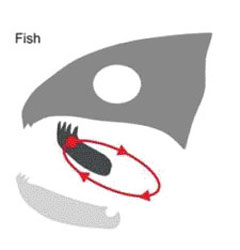|

How fish and mammals chew
New research from Brown University shows that fish and mammals chew
differently. Fish use tongue muscles to thrust food backward, while
mammals use tongue muscles to position food for grinding.
The evolutionary divergence is believed to have occurred with
amphibians, though further research is needed to identify which species
and when. Results are published in Integrative and Comparative Biology.
|
 
Fish use tongue muscles primarily to funnel the food farther
into the mouth for processing, while mammals use tongue muscles
to position the food. |
Evolution has made its marks -- large and small -- in innumerable
patterns of life. New research from Brown University shows chewing has
evolved too.
Researchers looked at muscles that control the movement of the jaw
and tongue in fish and in mammals.
They learned that fish use tongue muscles primarily to funnel the
food farther into the mouth for processing, as if the morsel were an
object in an assembly line. Mammals use tongue muscles to position the
food, so that jaw muscles can best use teeth to chew the food.
Chewing styles for different purposes
.The difference in chewing shows that animals have changed the way
they chew and digest their food and that evolution must have played a
role.
"It's pretty clear that all of these animals chew, but the
involvement of the tongue in chewing differs," said Nicolai Konow, a
postdoctoral researcher at Brown and the lead author on the study,
published in the journal . And that brings up the question of what the
muscles associated with the tongue and the jaw are doing."
In 2008 and last year, Konow and colleagues published papers showing
the chewing technique of bowfin, pike, and fish with tiny teeth on their
tongues such as salmon and osteoglossomorphs (fish with bony tongues).
In some of these species, the researchers showed that chewing begins
with the tongue positioned in the upper mouth.
Then the fish fires the muscle, called the sternohyoid, downward,
retracting the tongue inward, before moving it forward again, and
upward, to its original position in the upper mouth. With the fish
facing left, the chewing cycle looks like an ellipse tilted at an angle,
with the tongue moving in a clockwise direction.
The finding was bolstered(supported) by earlier research by other
scientists that showed the same chewing pattern in other fish, including
bichir (a freshwater fish in Africa), gar, and, importantly, lungfish,
which is believed to represent an early stage in the transition of some
species from exclusively water- to land-dwelling.
In this paper, Konow and his team studied how the muscles of three
mammals acted during chewing: alpacas, goats, and pigs.
They outfitted each with electrodes planted in the jaw and tongue
muscles to pinpoint the activity of each set of muscles during chewing.
The analysis indicated that the animals' tongues thrust forward, and
upward, as they began to chew and then fell back, or retracted, to their
original position.
With the animals facing left, the tongue traces an ellipse in a
counter-clockwise direction for each cycle.
The distinction between fish and mammal chewing is likely there for a
reason, Konow said. With fish, the tongue's function is to transport the
food quickly into and through the mouth, where, in many species, an
extra set (or sets) of jaws will grind the food. In addition, the tongue
moves oxygenated water through the mouth to the gills, helping the fish
to breathe.
Mammals, on the other hand, use their tongues to set the food in the
right spot in the mouth to maximize chewing. But even among closely
related species, there is a surprising difference: Herbivores, such as
alpacas and goats, were less coordinated during chewing than omnivores,
represented by the pigs.
Cud-chewing animals were not as monotonously rhythmic in their
chewing as many would believe.
"It is a puzzling finding," Konow said. "We think the herbivore needs
the bolus (the soft mass of chewed food) to be in a precise place
between each chew. So the tongue may be constantly moving around to make
sure the bolus is in the right place between chews."
Next came the task of figuring out where, when and with what species
the divergence in chewing emerged. That makes sense, Konow plans to look
next at amphibian chewing. "
Science Daily
PEN-PALS
Name: Ovini Chamathka
Jayasinghe
Gender: Female
Age: 13
Hobbies: Reading story
books, collecting stamps, watching TV, listening to music
Pen pals preferred from:
France, England, Japan, China, especially Sri Lanka
Address: 149/15,
Pihillakanda Estate, Thawalankoya, Ukuwela, Sri Lanka.
......
Name: B.A.Chamudi
Anuththara
Gender: Female
Age: 10
School: Sri Saralankara
K.V.
Pen pals preferred from:
UK, Japan, USA, Australia, Sri Lanka
Age group: 8-11
Address: 32, Senapura,
Kindelpitiya, Welmilla Junction, Sri Lanka.
.....
Name: R.C.Madushani
Fernando
Gender: Female
Age: 16
School: St.John the
Baptist K.V., Kochchikade
Hobbies: Reading
newspapers, collecting stamps, watching TV, listening to music, singing
Pen pals preferred from:
Australia, France, Singapore, especially Sri Lanka
Age group: 13-16
Address:: 24, Sapumal
Uyana, Jambugas Watta, Katana north, Katana, Sri Lanka.
.....
Name: K.D.Dananjani Perera
Gender: Female
Age: 13,
School: Sailan
International School
Hobbies: Reading
newspapers, collecting stamps, watching TV, listening to music and
singing
Pen pals preferred from:
UK, Japan, Germany
Age group: 12-14,
Address: 100/C, Nildiya
Pokuna Mawatha, Raddoluwa, Kotugida, Sri Lanka.
.....
Name: S.Prabodhika
Ekanayaka
Gender: Female
Age: 13
School: Ibbagamuwa Central
College
Hobbies: Reading
storybooks, collecting stamps, watching TV, listening to music
Pen pals preferred from:
UK, Japan, Sri Lanka especially (Nuwara Eliya)
Age group: 12-14,
Address: C/o
E.M.P.B.Ekanayaka, E.M.Sammani, Madugalla Junction, Polpithigama, Sri
Lanka.
......
Name: L.A.Dilshara De
Silva
Gender: Female
Age: 13
School: Lyceum
International School, Wattala
Hobbies: Swimming, reading
story books, watching TV, listening to music
Pen pals preferred from:
Any country, especially Sri Lanka
Age group: 12-14,
Address: 280/9,
Sriyakantha Gardens, Waragoda Road, Kelaniya, Sri Lanka |

